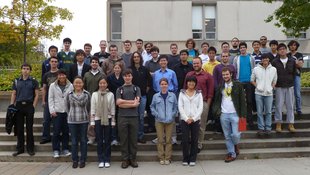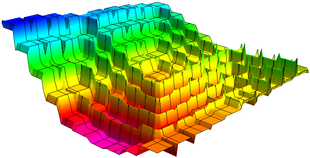| Additions to the MAT 327 web site no longer count towards good deed points
|
| #
|
Week of...
|
Notes and Links
|
| 1
|
Sep 13
|
About This Class, Monday - Continuity and open sets, Thursday - topologies, continuity, bases.
|
| 2
|
Sep 20
|
Monday - More on bases, Thursdsay - Products, Subspaces, Closed sets, HW1, HW1 Solutions
|
| 3
|
Sep 27
|
Monday - the Cantor set, closures, Thursday, Class Photo, HW2, HW2 Solutions
|
| 4
|
Oct 4
|
Monday - the axiom of choice and infinite product spaces, Thursday - the box and the product topologies, metric spaces, HW3, HW3 Solutions
|
| 5
|
Oct 11
|
Monday is Thanksgiving. Thursday - metric spaces, sequencial closures, various products. Final exam's date announced on Friday.
|
| 6
|
Oct 18
|
Monday - connectedness in  , HW4, HW4 Solutions, Thursday - connectedness, path-connectedness and products , HW4, HW4 Solutions, Thursday - connectedness, path-connectedness and products
|
| 7
|
Oct 25
|
Monday - Compactness of ![{\displaystyle [0,1]}](https://wikimedia.org/api/rest_v1/media/math/render/svg/738f7d23bb2d9642bab520020873cccbef49768d) , Term Test on Thursday, TT Solutions , Term Test on Thursday, TT Solutions
|
| 8
|
Nov 1
|
Monday - compact is closed and bounded, maximal values, HW5, HW5 Solutions, Wednesday was the last date to drop this course, Thursday - compactness of products and in metric spaces, the FIP
|
| 9
|
Nov 8
|
Monday-Tuesday is Fall Break, Thursday - Tychonoff and a taste of Stone-Cech, HW6, HW6 Solutions
|
| 10
|
Nov 15
|
Monday - generalized limits, Thursday - Normal spaces and Urysohn's lemma, HW7, HW7 Solutions
|
| 11
|
Nov 22
|
Monday -  and and  , Thursday - Tietze's theorem , Thursday - Tietze's theorem
|
| 12
|
Nov 29
|
Monday - compactness in metric spaces, HW8, HW8 Solutions, Thursday - completeness and compactness
|
| 13
|
Dec 6
|
Monday - Baire spaces and no-where differentiable functions, Wednesday - Hilbert's 13th problem; also see December 2010 Schedule
|
| R
|
Dec 13
|
See December 2010 Schedule
|
| F
|
Dec 20
|
Final exam, Monday December 20, 2PM-5PM, at BR200
|
| Register of Good Deeds
|

Add your name / see who's in!
|

See Hilbert's 13th
|
|
Some blackboard shots are at BBS/10_327-100930-143624.jpg.
|
|
Dror's notes above / Student's notes below
|
|
Here are some lecture notes..
Lecture 6 page 1
Lecture 6 page 2
Lecture 6 page 3
Lecture 6 page 4
Lecture 6 page 5
D 12:48, 2 October 2010 (EDT) finite Hausdorff space: The only topology satisfying Hausdorff for a finite set A is the discrete topology; for each distinct point x and y in A, {x} and {y} are disjoint. Also, every finite point set in A is closed. We can check that using the discrete metric on A (d(x,y) = 1 if x =/= y, d(x,y) = 0 if x=y), a sequence of points in A can converge to only one point at most. Also note that Hausdorff condition is stronger than T1.
Discrete topology implies Hausdorrf condition is obvious. The converse we can prove by contradiction so that its much clearer. Suppose the space X is Hausdorff but it does not have discrete topology. So some finite subset A would not be open. A complement is a finite subset of X would not be closed. That cannot happen because Hausdorff condition implies T1 so that any finite union of singleton set should still be closed. Contradiction here. -Kai Xwbdsb 13:31, 4 October 2010 (EDT)

![{\displaystyle [0,1]}](https://wikimedia.org/api/rest_v1/media/math/render/svg/738f7d23bb2d9642bab520020873cccbef49768d)



